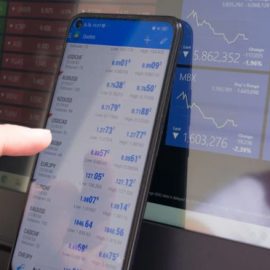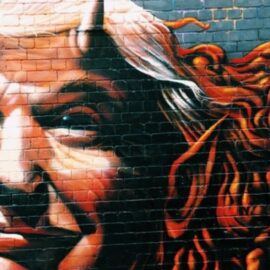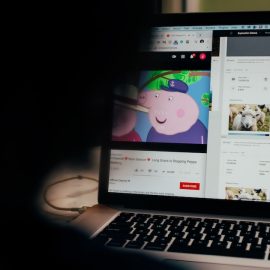

This article is an excerpt from the Shortform book guide to "Business Adventures" by John Brooks. Shortform has the world's best summaries and analyses of books you should be reading.
Like this article? Sign up for a free trial here .
What’s a short squeeze? Who profits? Who loses?
Making the case that people are the stock market’s most volatile component, John Brooks recaps how a man from Memphis named Clarence Saunders “cornered” his own company’s stock, meaning he obtained enough shares to give him the power to manipulate its price. It wasn’t a calculated move on his part; it was a reaction to Wall Street speculators who had planned an attack on his company, a chain of supermarkets called Piggly Wiggly. The affair serves as an interesting illustration of a short squeeze.
Continue reading to learn about the Piggly Wiggly short squeeze as well as the recent incident with GameStop.
Traders Try to Short Piggly Wiggly
What’s a short squeeze? An unusual occurrence in the stock market, it’s a set of circumstances that can cause a stock’s price to rise extremely quickly. In the Piggly Wiggly affair, the story began in the fall of 1922, when a number of the store’s franchises went bankrupt. Some stock market traders anticipated that news of the bankruptcy would lead to a dip in the stock’s value, so they planned a bear raid: They borrowed Piggly Wiggly shares with the intent to sell, wait for the price to drop, and repurchase the shares at a cheaper price. Once they returned the borrowed shares, they would make a profit from the price difference. This is called shorting the stock.
(Shortform note: The Securities and Exchange Commission (SEC) wasn’t established until 1935, so there were no formal regulations to guard against such schemes. Bear raids are now illegal under SEC rules, which specify that short sales—selling stock you don’t own with the intention of buying it at a lower price before you have to return it—can only be done on an uptick. It’s also illegal to collude with others in a coordinated short-selling effort and to spread negative rumors about a company to force the price of a stock down.)
Saunders Fights Off the Short Squeeze
When Saunders realized what the short sellers were trying to do, he was enraged. He wanted to protect his company and also to punish the Wall Street investors, so he used his own funds plus a $10 million loan to purchase most of the Piggly Wiggly shares.
This did two things: First, it drove the price of the stock up, so that the short sellers would lose money, and it ensured that he was almost the only investor with spare stock, so that when short sellers borrowed the stock they were trying to short, they were actually borrowing from him (they didn’t know this).
Once Saunders had driven the price up, he had the short sellers cornered—he demanded that they return their borrowed stock. The short sellers, required by New York Stock Exchange (NYSE) rules to produce the stock by the next day, had no option but to purchase the shares from Saunders himself. They scrambled to buy shares, which drove the price upwards; that is, until the NYSE suspended all trading in Piggly Wiggly. Two days later, the NYSE permanently barred Piggly Wiggly from trading and broke its own rules by extending the short sellers’ deadline for compliance. This gave short sellers ample time to find and purchase the shares that Saunders didn’t own.
This enraged Saunders even more, and he denounced the NYSE for its unfairness and arbitrary rules. The Exchange responded by saying that its actions were within its power and that it was wholly justified to do what was necessary to protect the market.
After paying his creditor-banks with the money he made from the short sellers, Saunders still had debts amounting to $5 million. His attempts to raise the money through newspaper ads, mail-order pitches, and impassioned appeals to the people of Memphis were unsuccessful. He was thus forced to declare bankruptcy and step down as Piggly Wiggly president.
| Can You Win Against Wall Street? The GameStop Story Many saw the Piggly Wiggly affair as a David-versus-Goliath battle and rooted for Saunders, but experts warn that it’s virtually impossible to win against Wall Street. Short squeezes, in particular, typically only lead to Pyrrhic victories. More recently, this theory was tested by a similar incident; this time, amateur investors on Reddit played the part of David. In 2021, numerous hedge funds had their eye on GameStop, a struggling company selling video games, consoles, and other electronics. They began short selling GameStop stock, hoping to make a profit when the company tanked—but their plans were upended by a Reddit forum called WallStreetBets. The Redditors saw a golden opportunity to exact revenge on rich investors whom they considered the purveyors of growing wealth inequality. R/WallStreetBets’ users bought and held onto GameStop stock en masse, sending the price soaring and hedge funds scrambling. With online trading platforms like Robinhood making the trading process easy and accessible for amateur investors, GameStop’s share price increased two-hundredfold from its price just 10 months before. Some hedge funds lost billions in the process. However, the Redditors’ triumph was short-lived: In the same way that the NYSE suspended trading on Piggly Wiggly, the Robinhood app eventually prevented users from buying GameStop stock, citing “market volatility.” This was a big factor in the stock’s price reversal. The events led to a congressional hearing, where the head of Robinhood denied that the platform restricted trading to protect Wall Street’s billionaires. The debacle also led to questions that have remained unanswered since Saunders’s time (does the system favor the rich?) as well as new questions emblematic of the current time (what, if anything, can be done about online forums’ concerted efforts to influence the price of a stock?). When the dust settled after the GameStop incident, some people lost money, some made money, and it was business as usual on Wall Street. As one writer notes: When it comes to Wall Street, the house always wins. |

———End of Preview———
Like what you just read? Read the rest of the world's best book summary and analysis of John Brooks's "Business Adventures" at Shortform .
Here's what you'll find in our full Business Adventures summary :
- A collection of essays about the unpredictability of corporations and Wall Street
- How businesses and economies can rise and fall based on people’s behavior
- A look at the major events that shaped the financial world as we know it






